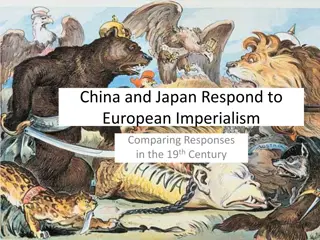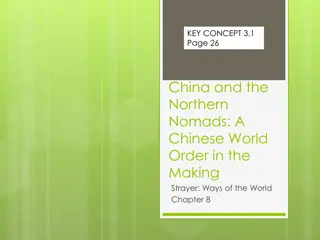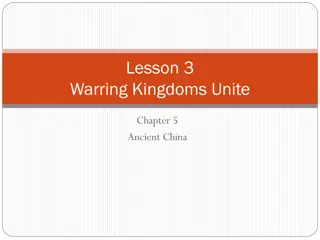Jewish Presence in China: A Unique Chapter in Jewish History
Jewish history extends beyond Europe to Asia, including China where evidence of Jewish presence dates back to the 9th century. Despite facing challenges such as assimilation, the Kaifeng Jews in Northeast China rose to high status in business and government. The decline of this community, now with only a few hundred descendants, reflects the complexities of cultural integration and religious freedom in China.
Download Presentation

Please find below an Image/Link to download the presentation.
The content on the website is provided AS IS for your information and personal use only. It may not be sold, licensed, or shared on other websites without obtaining consent from the author.If you encounter any issues during the download, it is possible that the publisher has removed the file from their server.
You are allowed to download the files provided on this website for personal or commercial use, subject to the condition that they are used lawfully. All files are the property of their respective owners.
The content on the website is provided AS IS for your information and personal use only. It may not be sold, licensed, or shared on other websites without obtaining consent from the author.
E N D
Presentation Transcript
1. Jewish history does not begin and end with Europe. 2. It is also Asian, both in origin and destiny.
1. There is evidence of Jewish presence in China since the 9thcentury, under the Sung dynasty. 2. Marco Polo (1200s) mentions prosperous Jewish merchants in China on the coastal cities. 3. Their numbers were small, unlike the case in India. 4. The best known were the so-called Kaifung Jews in Northeast China.
1. A small Jewish community in NE China. 2. Over the long stretches of time, their numbers declined thru marriage with the Han Chinese. 3. Important point: Jews were not persecuted in China, unlike the case both under Christianity and under Islam. 4. Jews in China, even tho small in number, rose to high status both in business and in some cases in government.
Kaifeng Jews developed a distinctive culture that was unquestionably Jewish, but progressively Chinese. 2. Their greatest problem was not separation from other Jews, but the openness of Chinese society. 3. Intermarriages occurred often. 4. Over time, they were so completely assimilated that few of their descendants carry any memory of Jewish ancestry. 5. They look much like other Chinese. The story of the Kaifeng Jews is dramatic and colorful. 1. .
1. This led to the community's demise. 2. A recent census showed only about 500 descendants of Kaifeng Jews. 3. The Chinese communist govt is opposed to religious revival.
1. There is a lot of American interest about Chinese Jews. 2. To fill their need, history is being re-created. The number of Chinese Jews will certainly grow. 3. This will cater to American and Israeli tourists.
Prof Daniel Elazar (1934-99) Jerusalem Center for Public Affairs, and of Temple University, Philadelphia.
There is no native Jewish population in Japan, unlike in India and to a smaller extent in China. But Japan played an important role in saving Jews during the WW11 holocaust.
1. Like China, there is much interest in Jews of Japan. 2. In 1800s, Rev McCloud, a Christian missionary, opined that the Japanese were one of the Lost Tribes of Israel. 3. Why? Because , like the Jews, the Japanese were creative, ingenious, and smart.
Sugihara was the Japanese vice-Consul in Lithuania, a neutral country in WWII. 1. During the War, Jews were fleeing Poland and Germany. 2. Sugihara issued MANY entry visas to Japan to the fleeing Jews. 3. Remember that Japan was an ally of Germany. But Sugihara ignored his orders and issued visas to fleeing European Jews. 4.
Israel honored him as one of the Righteous Among the Nations (Hebrew: ).
Dr. George Bluman, professor in Canada, has written an impassioned book on Sugihara. Persona non-Grata is a short film on Sugihara life. Check the web. Dr. Bluman: 200,000 descendants of the people saved by Sugihara, among these Dr. Bluman, himself.
1. Shanghai was under Japanese control during the War. 2. Shanghai was one of the few places in the world where one didn't need a visa. 3. Many European Jews took advantage of the open city and traveled on land or sea with much hardship. 4. The Germans pressured the Japanese allies to expel or to exterminate the Jews. The Japanese ignored the orders. 5. Most of these Jews later migrated to Israel, Canada and the US. 6. Among these was Michael Blumenthal: the US secretary of the Treasury.
A Jewish refugee in Shanghai
He was a German-born American business leader, economist and political adviser. He served as the Treasury Secretary of the United States under President Jimmy Carter from 1977- 1979. At age thirteen, Blumenthal barely escaped Nazi Germany with his Jewish family in 1939. He was forced to spend World War II living in the enclave of Shanghai in China, then under Japanese control. Blumental also served as the director of the restored Jewish Museum in Berlin. He is the author of From Exile to Washington (2013).
A small but important trail of refugees fleeing the Nazis took an unusual detour through China. A new exhibit in Brooklyn marks the journey.
Thanks for watching. uwf.edu/lgoel























